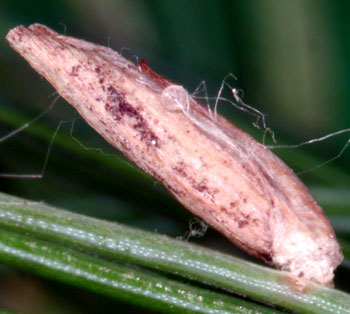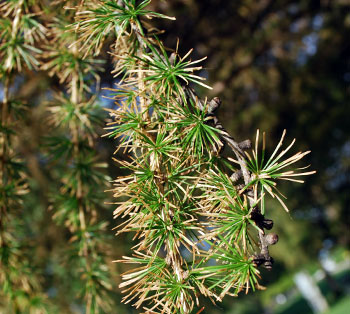Tamaracks are looking brown
The larch casebearer is causing many tamaracks to turn brown across Michigan.

Tamarack needles are turning brown in many areas of the northern Lower Peninsula, and the central and eastern Upper Peninsula. Tamarack (Larix larcinia), also known as American Larch, is an unusual conifer in that it loses its needles each year in the fall. Natively it is found primarily in wet lowlands where it grows in best in full sunlight. The culprit causing the browning is a tiny caterpillar called the larch casebearer (Coleophora laricella). The larch casebearer can be a serious defoliator of tamarack of all ages. It was introduced from Europe and was first recorded in Massachusetts in 1886. It now occurs throughout most to the range of tamarack in North America.
The larch casebearer derives its name from the case it constructs. The case is formed by parts of a mined-out needle that the tiny larvae line with silk. As the larvae grow, the case is enlarged and it provides camouflage, making the larvae very difficult to see. The case bearer over winters within its case firmly attached to a branch, most often near the base of a bud. They begin to feed in May as soon as new needles appear. A larva fastens its case to a needle with silk and then mines the interior as far as it can reach without actually leaving the case. Damaged needles look as though they have been bleached or scorched.


Left, The distinctive “cases” of the larch casebearer. Right, Damage to the needle tips can appear scorched. Photo credits: Gyorgy Csoka, Hungary Forest Research Institute, Bugwood.org (left) and Jill O’Donnell, MSU Extension (right)
The larvae should be finished feeding soon and will pupate inside the needle case. The silvery gray moth will emerge in late June or early July, depositing eggs in the needles. When the eggs hatch, the tiny larvae will feed within the needle for a couple of months before overwintering. The most evident damage occurs in the spring when the foliage shrivels and dies. Generally, although trees turn completely brown, they will reflush by mid-summer and recover, however, if defoliation occurs for two or more consecutive years, the tree may be killed.
The good news is that a number of parasites have been imported from Europe to combat the casebearer. These parasites have widely established and are believed to be the reason that outbreak severity has diminished throughout North America. For homeowners with severe casebearer issues on their tamarack trees, there are two times to control these insects. The first is in the spring when they begin feeding on the new growth. Right now it is probably too late to be effective, since much of the damage has been done and they are close to completing the feeding stage. The second time to control the overwintering larvae is in late August through mid-September; however, control measures are rarely needed to protect the health of the tree.



 Print
Print Email
Email


